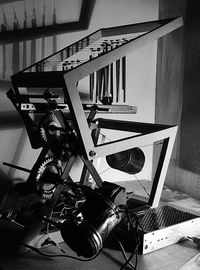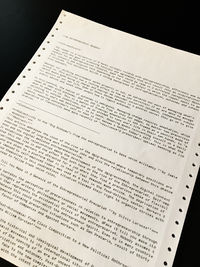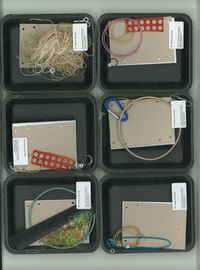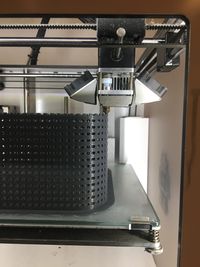User:Artemis gryllaki/Writing & Research Methodologies
PROJECT DESCRIPTION (300 words)
Version 1
WHAT
The “x_Sound” machine is an interactive construction which produces multiple deafening sounds, in relation to the distance between a passer-by and the machine. It consists of a metal frame X-shaped, which supports the mechanism of three gears and a rack, and a wooden frame S-shaped, which carries twelve metal wind chimes. Eight metal rods penetrate axially these two structural frames helping the machine to stand independently. Basic point during the construction of the machine was the reuse of materials, like the gears of a car’s gear box, the drive of a drawer, the wooden surface of a cupboard, metal tubes from wind chimes (musical instrument), a canned box and parts from the metal frame of a table.
HOW
The machine tries to detect whoever is nearby, in order to force them to listen to its annoying harmonies. If the output sound of the machine repels the spectator from coming close, it will remain inactive. An ultrasonic sensor (rangefinder) identifies someone at 60cm distance, thus activating the moving parts of the machine, in order to produce different sounds. There are two motors which activate the machine, a “servo” motor and a “wiper” motor. The first rotates the baquette pounding the drum rhythmically in different speed. The second activates the gears, which force the rack to move back and forth, hitting the metal wind chimes, thus creating melodies.
WHY
The “x_Sound” machine is an assemblage composed of found-objects, which could be considered as “junk”, inspired by the sculptural, yet pointless machines of Jean Tinguely. It creates a game between the spectator and the machine, as a form of action-reaction grounded in the programming environment of Arduino. It has the ambition to redefine the mechanical ingenuity of 20th century’s kinetic art in the contemporary post-digital era. It can be also regarded as a humble attempt to mock the "improvements" of modern technology and the post-digital society.
REMARKS
A natural sense of flow making it comfortable for readers, bo suggested that the description of the music can be more ?dynamic? (that she's very curious about the sound). Unmark "improvement". Use of architectural terms, how to remedy that for people who are not familiar to architectural terms (like axially)?
Version 2
The “x_Sound” machine is an interactive construction which produces multiple deafening sounds, in relation to the distance between a passer-by and the machine. It consists of a metal frame X-shaped, which supports the mechanism of three gears and a rack, and a wooden frame S-shaped, which carries twelve metal wind chimes. Eight metal rods penetrate through the two structural frames helping the machine to stand independently. Basic point during the construction of the machine was the reuse of materials, like the gears of a car’s gear box, the drive of a drawer, the wooden surface of a cupboard, metal tubes from wind chimes (musical instrument), a canned box and parts from the metal frame of a table.
The machine tries to detect whoever is nearby, in order to force them to listen to its annoying harmonies. If the output sound of the machine repels the spectator from coming close it will remain inactive. An ultrasonic sensor (rangefinder) identifies someone at 60cm distance, thus activating the moving parts of the machine, in order to produce different types of sounds. There are two motors which activate the machine, a “servo” motor and a “wiper” motor. The first rotates the baquette pounding the drum rhythmically, making hollow metal staccato sounds performed in various speeds. The second activates the gears, which force the rack to move back and forth, hitting the metal wind chimes, thus creating sharp metallic and clanging sounds that compose playful melodies. This noise symphony is completed by the continuous grinding and clunking noise that comes from the rotational motion of the gears.
The “X_Sound” machine is an assemblage composed of found-objects, which could be considered as “junk”, inspired by the sculptural, yet pointless machines of Jean Tinguely. It creates a game between the spectator and the machine, as a form of action-reaction grounded in the programming environment of Arduino. It has the ambition to redefine the mechanical ingenuity of 20th century’s kinetic art in the contemporary post-digital era. It can be also regarded as a humble attempt to mock the improvements of modern technology and the post-digital society.
THE ENTREPRECARIAT READER
Assembly, Chapter 9: Entrepreneurship of the Multitude
- Author: Michael Hardt & Antonio Negri
- Publisher and date: Oxford University Press, 2017
Abstract:
In chapter 9 of “Assembly”, Michael Hardt and Antonio Negri attempt to redefine the meaning of “entrepreneurship”. The “entrepreneurship of the multitude” as proposed by the authors, is capable of forming new social combinations, pointing to autonomous social production and reproduction.
Synopsis In the “Entrepreneurship of the Multitude”, Michael Hardt and Antonio Negri perceive language and communication as significant political tools. They argue that neoliberal politicians often distort political “terms and concepts” and separate them from their original historical context, in order to support their arguments. With a focus on political antagonism, Hardt and Negri suggest that we should claim back words that have been diverted and give them our own interpretations, hence forming new alternatives. In chapter 9 of "Assembly", there is an attempt to redefine the meaning of “entrepreneurship”.
The chapter begins with Joseph Schumpeter’s description of the “entrepreneur”, as a person whose special ability is to create “new combinations” among already “existing workers, ideas, technologies, resources and machines”. The construction of these new “machinic assemblages” is a vital aspect of productivity growth. The heroic figure of the capitalist entrepreneur, portrays a “man of action”, who “gets things done” and becomes a role-model for the masses.
However, this perception hides an important part of the entrepreneurial process, which is the labor itself. Under the praised work of the capitalist entrepreneur, lies the constant expropriation of the cooperative power of the multitude. The entrepreneurial function does not belong a manager or a guru. On the contrary, it is accomplished through cooperation. As the main actors of production process, the workers collaborate, while limiting their individuality and thus create social wealth. Under this condition, the maximum human powers can be unveiled.
At this point, Hardt and Negri introduce the novel term of “entrepreneurship of the multitude”. In postmodern global economy, the production process is progressively based in new networks of collaboration and communication, in coordination with contemporary technologies. On these terms, the labor gradually acquires a degree of autonomy in production. Provided that today workers manage their social relationships and make decisions together, in the future they could set goals on their own, and eventually accomplish self-direction.
In regard to the term itself, "entrepreneurship of the multitude" can be tricky and lead to misinterpretation. Hardt and Negri clarify that their approach stands apart from “social entrepreneurship”. They argue that after the collapse of the welfare state, this practice, despite its rhetoric, failed to provide sustainable aid to the weakest parts of society. Instead, it proved harmful to existing solidarity networks of local communities in developing countries, by forcing them to follow the logic of the market.
The “entrepreneurship of the multitude” as proposed by the authors, is capable of forming new social combinations, pointing to autonomous social production and reproduction. Admittedly, people are not naturally oriented to collective self-rule. Nevertheless, Hardt and Negri believe in the power of people’s assembly. Social movements need to connect with labor organizing, and form what is referred as “social unionism”.
In conclusion, the “multitude” has the potential not only to reject the current social system as we know it, but use its entrepreneurial spirit to build novel forms of cooperation. Ultimately, the triumph of private property will be abandoned. In its place, the “autonomous organization of social cooperation” can build the ground where “social wealth is shared in common”.
Glossary
Team: Artemis, Paloma, Pedro, Simon
- Subjectivity: As a philosophical concept, subjectivity has its roots in the writings of Descartes and Kant. Modern discourse on subjectivity is often articulated by understandings of what constitutes an individual, and concepts of the self in relation to one's environment. Broadly speaking, subjectivity concerns the position of a subject as an individual (with consciousness, perspectives, feelings, desires etc.), the subject's agency, or ability to act on objects, and also information that is considered true from the perspective of a subject.
- Self-precarization: Precarization stems from individuals reacting to economic circumstances where there is uncertainty. Isabell Lorey extends the concept to "self-precarization", which she defines as a precarization that is both forced and chosen; giving as an example of one choosing less-creative, precarious jobs in order to fund one's own cultural production within a state-imposed narrative that offers no alternative. In this way, self-precarization is a reaction to the top-down imperative to improve oneself through self-governance.
- Gig-economy: The term is often applied in an economic system where long-term work contracted jobs are not a reality anymore and companies prefer to outsource temporary positions. It has its origins in the 1920's jazz musicians, being slang for a live musical performance, especially one that does not have a certain future or that is temporary. The term gig also derives has a "short" for engagement.
- Platform Capitalism: We can consider it as a digital mediated form of entrepreneurialism. Companies such as Deliveroo, Uber or Glovo, recruite large numbers of workers, outsourcing their job positions through online systems as websites, apps, etc. Workers are self-employed, creating most of the times a fake sense of freedom.
- Social pyramid: Term introduced by Joseph Schumpeter which categorise the society in ranges in an pyramidal structure distinguishing roles of each layer of society and relations between large social groups and headed by entrepreneurs because of their ability to innovate.
- Entreprecariat: This term was born as a mixture between entrepreneurialism and precariat concepts. The entreprecariat is the semi-young enthusiastic creative worker who is forced to reinvent himself as an entrepreneur of the self due to his working conditions are undervalued in a financial, psychological, affective, physiological, temporal or geographical aspect.
- Social Unionism: Social Unionism is the concept of integrating workers, trade unions and the labor movement into broader alliances for social and economic justice. The attempt to connect social movements with labor organising points to the achievement of mutual beneficial goals and the re-appropriation of “the common”.
- Entrepreneurship of the Multitude: This term is suggested by Michael Hardt and Antonio Negri, as an attempt redefine the concept of "entrepreneurship". The "entrepreneurial spirit" is broadly referred as the special ability of neoliberal managers and gurus to maximize production and create individual profit. In contrast, with this new term the entrepreneurial mindset is claimed back by the multitude, as an inherent feature in social production processes. The goal is in this case is “self-organization and self-governance”, with the intention to build the ground where “social wealth is shared in common”.
ARCHIVING: TEN THESES ON LIFE HACKS
Team: Artemis, Paloma, Simon, Tancredi
Overview
Ten Theses on Life Hacks is the first publication of Special Issue #07. It attempts to acquire a widened perspective on how Life Hacks can be defined and how they relate to our collective experiences and reflections. Life Hacks are small improvisational interventions to the immediate environment; spontaneous actions that aim to improve or adapt materials to specific needs. A simple example, such as tying a knot in a earphone cable to determine easily which is for the left ear or the right without having to look, can be considered a Life Hack. They are diasporic, shared within communities both on- and offline in ever-increasing processes of self-optimisation.
The text consists of ten theses, the first of which is a selection of criteria that allow us to test whether something is a Life Hack or not. The remaining theses present extended arguments supported by examples, on how to identify specific features of Life Hacks, in which environment (and space) they exist and what kind of culture they foster.
Understanding Life Hacks in the context of an advanced capitalist society raises the question of the ambiguity of a system in which the entrepreneurial routine of the self is internalized to perform an ever-working life. In actuality, Life Hacks bring about the possibility of reappropriating everyday life in a creative and practical response, managing precarity and complexity.
This publication includes a Life Hack in its format. With the addition of a series of holes, each loose page can be seen as a “hackable surface”. The publication aims to depart from the traditional form of a finished book, inviting readers to bind it using an eclectic choice from a range of unorthodox materials included with the publication. This strategy incentives the reader to rethink their personal ideal form of the book, transforming it into a hand-made object. As such, the publication is completed by the reader, who is left to improvise a make-shift solution to bind the publication. The goal is not only to share the text, but to also provide an experience in which a life-hacked binding transforms the reader into an active subject, rather than a passive consumer. This small conceit illustrates that the process is even more noticeable than the outcome.
INVENTORY OF MATERIALS AND PROCESSES
Recycled kraft board
Paper (200gsm )
Cling wrap
Sticker label
Disused polystyrene food packaging trays
A wide range of unorthodox binding materials (e.g. paperclips, carabiners, rubber bands, nuts and bolts, earrings etc.)
PUBLICATION LAUNCH
Launched at Varia, the Centre for Everyday Technology (Rotterdam) on 31.10.18 as part of the event "Life Hacks: Space", including guests; author and designer Françoué Giraremeunier, the WORKNOT! collective (Arvand Pourabbasi and Golnar Abbasi), Varia, the Centre for Everyday Technology (represented by Roel Roscam Abbing, Manetta Berends and Niek Hilkmann). The Life Hacks series is curated by Silvio Lorusso, and jointly organized by Het Nieuwe Instituut’s Research Department and XPUB.
ARCHIVING: IRIS
Team: Artemis, Paloma, Simon, Tancredi
Overview
Iris is a physical device, ostensibly, an “artificial intelligence”, whose aim is to increase productivity. It is installed in work environments where workers can easily interact with it. However, the device is inhabited by three different personalities: Corporate Guru, Pirate Signal and Announcer. The interactions with and conflicts between these three personalities forces the user to adopt a reflexive and critical attitude toward the device. The user triggers the performance and is placed in an ambiguous position; doubtful if the emphasis is on productivity or happiness.
Iris takes the appearance of a manufactured product; a compact 3D printed shell that contains a raspberry Pi and two speakers, and at the top of the device, an infinity mirror with an LED strip and a camera. When it detects movement via the camera it starts to speak, and the LEDs, connected to the audio levels of the output, start to glow at different intensity in relation to the strength of the audio signal. When the device is active, the infinity mirror produces a combination of an endless light corridor and a faint reflection of oneself.
The Corporate Guru invites the user to repeat positive affirmations and invite self-inquiry into their thoughts as part of a meditative session. Its soothing voice is interrupted unexpectedly by the raspy, computerised whisper of a Pirate Signal, who responds to the Guru with snarky asides that cast doubt on the Guru's instructions and the very process of taking part in such sessions. Whether the Pirate Signal is part of the corporate manufacturer's design or not is not clear; it could easily be coming from an outside infiltrator (e.g. a hackivist) whose aim is to subvert the process. The third voice is of an Announcer, who, every hour, between 9:00 and 17:00 (apart from a lunch break at 13:00), describes a work-related problem and a Life Hack which addresses it, reminding workers of their autonomy and suggesting practical ways to improve their everyday lives in small, improvisational actions.
Iris follows the conclusion of the first part of the publication, 'Ten Theses on Life Hacks', in which we outlined the meaning of the ambiguity within "Life Hacks", everyday actions which address both an improvement of personal life and an excess of productivity that can eventually lead to burn-out. The aim was to create a device to let the user experience this ambiguity in a clear way and develop their own critical position.
We chose the environment of the work space as the site of a live interaction between the main character of the entreprecarious worker, and an AI which represents the ideal virtual coach. Iris is capable of incapsulating this ambiguity in itself and making the user conscious of it through natural language. Further developments consisted of how to embody this ambiguity into one AI and at the same time announce Life Hacks that can be executed by the user. To manage this complexity we decided to assign three characters to Iris and developed their interactions as a kind of struggle between these different perspectives.
INVENTORY OF MATERIALS AND PROCESSES
Transparent and mirrored acrylic (laser-cut) PLA filament (3D-printed) Tinted one-way mirror film Bluetooth JBL speakers (x2) Raspberri Pi 3 B+ Raspberry Pi Camera + flexi cable LED strip WS1 + charger Audio jack (x2) and splitter Wires and jumper wires
PUBLICATION LAUNCH
Launched at Het Nieuwe Instituut on 13.12.18 at "Life Hacks: Introducing Iris (XPUB Special Issue #07)", the third event of the Life Hacks series. Following the launch of Ten Theses on Life Hacks, XPUB's Special Issue #07 is a further step of an inquiry into the meaning of Life Hacks. The Life Hacks series is curated by Silvio Lorusso, and jointly organized by Het Nieuwe Instituut’s Research Department and XPUB.
PERSONAL RESEARCH
Ways of ascertaining the truth. How do we educate a group? Form a subject; divide the jobs; how to make an article; Independent academic research: is this possible? This HAS to be connected to specific circumstances. Trying to think of digital tools that can help and not distract you from an overload of information. In the context of urban planning, there are some gestures to inclusivity (participatory design) but they are often limited. In order for them to work, media literacy would be necessary; is it possible to guide people and have a clear procedure for imparting information?
Task: Make rapid prototypes of real situations where the problem precedes the software solution (meaning, design the solution to the problem). Books to look at: Imaginary Futures-Richard Barbrook, Clive Bell-Toward the Year 2000
First Draft
Problems of urban transformations:
-NOT clear procedures?
-NOT mutually defined problems to be solved
-NOT inclusivity of citizens during and after the design
How to define problems in a democratic way?
Discussion between specialists, politicians and citizens:
-specialists design, trying to solve problems
-citizens review designs, vote for designs, keep informed during and after the design
-process evaluated in the end
Potential Digital Tools
- Tool 1: Defining the problem via survey – platform for democratic dialogue
- Tool 2: Documentation of meetings among different parties – public/clear platform/archive
- Tool 3: When there is a defined design to be made, more defined choices to choose among – platform for citizens to express their expectations/visions/proposals, how do they imagine the space with arguments why
- Tool 4: After designers have proposals – platform to vote their favorites/choose
- Tool 5: Review of final design – platform to discuss what happened, how did the final decision work
Real Situations Rapid Prototypes
1.
PROBLEM: In a densely built area in the center of Athens citizens complain that there is not enough open-air space. It is decided that a parking plot should be transformed into a pocket-park. WHERE is this going to be? WHAT is the optimal spot according to everyone’s interest?
TOOL: Digital Platform with registration to vote for the best spot of the pocket park, according to the available parking spots that can be used.
2.
PROBLEM: Inhabitats in the area of Amstelveen station just here that a new 20 floors building is going to be constructed near the area that they live. They are not aware of what is going to be there and they had no role in the decision of which uses are needed in this area. There are several parties taking part in the discussion of what kind of uses does the new building in Amstelveen station will have. The parties who participate in the meetings are: Municipality, Developers of the building, Owner of the plot, different companies-ngos-individuals who want to be hosted there, the Urban design office and the Architecture office which are going to design the building. Citizens are not aware of these procedures and just only hear about the final design at the end of these meetings.
TOOL: Meetings/or the result of meetings should be documented each time in a digital public platform, and stored as archive so citizens can actually follow the development of the discussions and be aware of what is going to be built in their area so the can approve of form opposition to it.
3.
PROBLEM: In a neighbourhood of social housing in Rotterdam, there was an initiative from a group along with the municipality to give a use to a inner yard of a big social housing construction. The yard now is empty with only grass and it is announced that they are going to build a small soccer field in the garden. 60% of the inhabitants are not happy with this cause they don’t play soccer and they would imagine another use of this open-air space.
TOOL: Before the final use is decided, there should be a survey + platform which ask the inhabitants of the ideal use of the place. They can choose from 10 different uses and if they want, describe how they imagine it. For example:
- WHAT do you want to do in this place?
-read
-sport
-watch movie
-drink coffee
-listen to music
-workshops
-political discussion
- HOW do you imagine the space according to your previous answer (more freedom in the answer)
-has a water element somewhere
-lots of trees
-more empty with benches and couches
-like a soccer field
-like a urban living room
-like an open library
-like a workshop – lab
-like an open cafeteria
-like a scene/cinema with chairs
Combining these answers and give percentages of them, the results are presented to the citizens and the direction of what is going to be built is much clearer. Designers are asked to designed the space that was decided, getting inspired by peoples visions.




